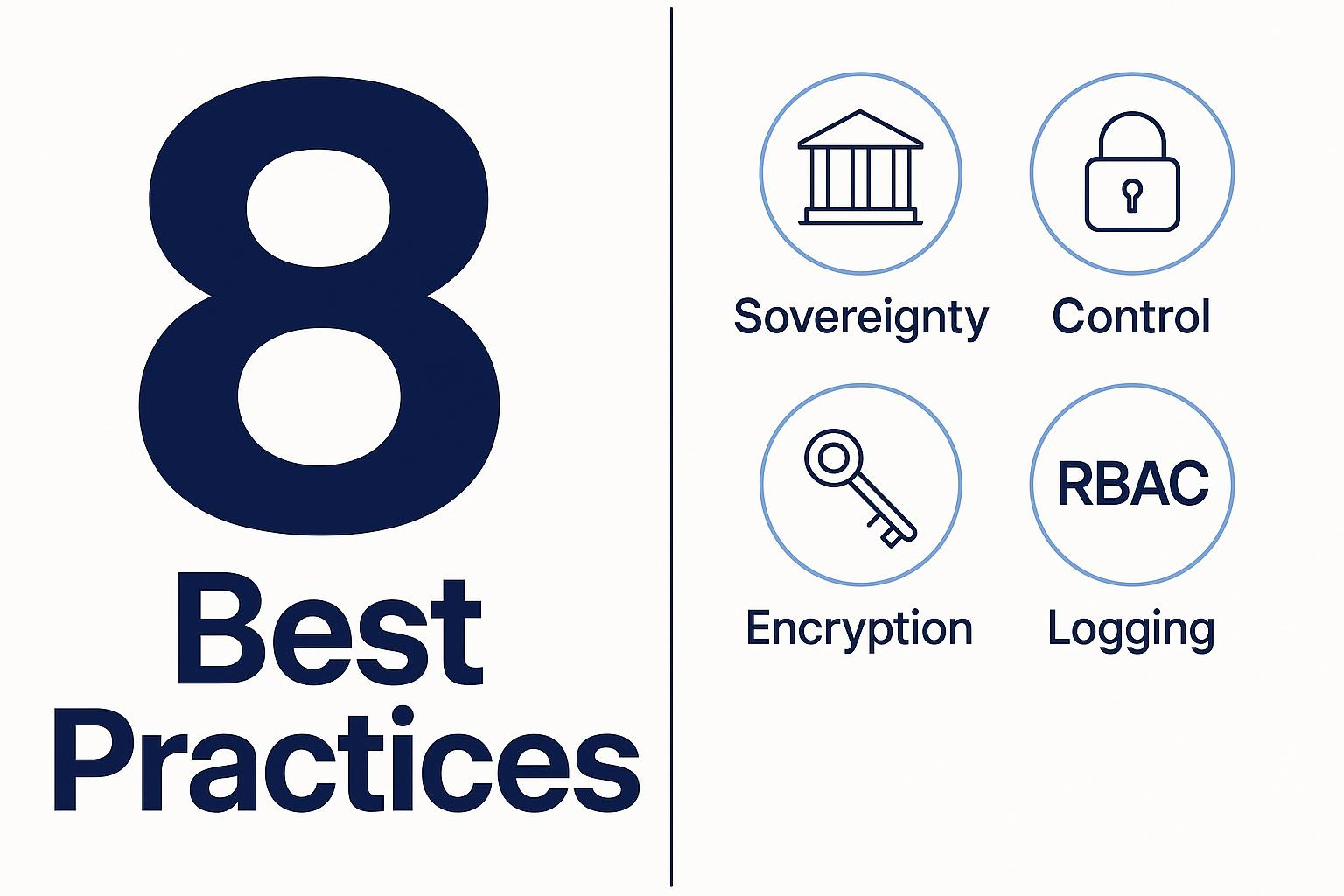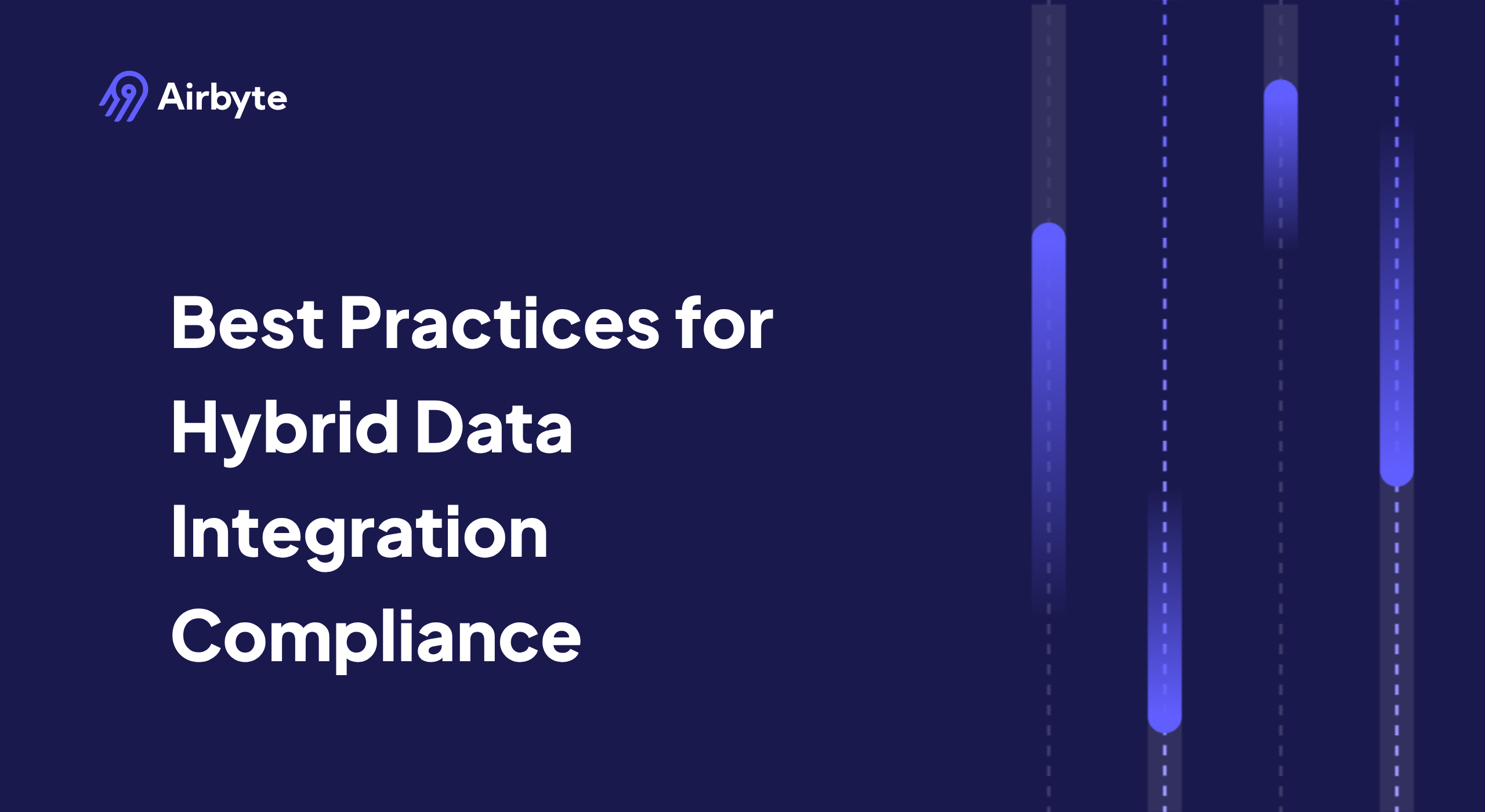Best Practices for Hybrid Data Integration Compliance
Summarize this article with:
✨ AI Generated Summary
When data moves between on-premises and cloud environments, compliance risks multiply dramatically. Every cross-environment transfer creates exposure to overlapping regulatory frameworks, from GDPR to HIPAA to EU DORA, while compliance requirements expand faster than most teams can address them.
You're managing region-specific residency rules while cloud-first tools often store connection metadata in infrastructure outside your control. Legacy ETL frameworks compound the problem. They weren't designed for immutable audit trails, making it difficult to demonstrate who accessed which records and when.
Airbyte Enterprise Flex addresses this challenge with a cloud-hosted control plane paired with a customer-owned data plane, allowing you to scale pipelines while keeping every sensitive byte within infrastructure you control. Compliance in hybrid data integration is about encryption, control, visibility, and documentation across every data plane.
What Are The Best Practices for Hybrid Data Integration Compliance?

You maintain compliance by ensuring that every technical decision, including scaling policies, serves a single goal: provable control over where data resides, who can access it, and how every byte is processed. The eight practices below build that control layer by layer.
1. Maintain Complete Data Sovereignty
Sensitive records should never leave infrastructure you own. Only lightweight metadata and orchestration signals pass through the hosted control plane; the actual payload stays inside your VPC, on-prem cluster, or regional cloud. This separation eliminates the risk that a vendor support ticket or background maintenance job exposes production credentials or regulated information.
A European bank that needed GDPR guarantees replicated customer transactions into an analytics warehouse running in the same EU region while using the cloud control plane only for job scheduling. By avoiding cross-border transit, it met strict residency clauses and sidestepped Schrems II transfer complications.
2. Use a Centralized, Auditable Control Plane
A single control plane gives you one policy surface instead of dozens. When Enterprise Flex runs that plane for you, it enforces version-locked connector images, captures every API call, and still lets you run workers in your own boundary. Cloud control, customer-controlled infrastructure. The result is uniform enforcement across on-prem, multi-cloud, and edge locations.
3. Encrypt and Tokenize Data End-to-End
TLS is mandatory for every hop: from the collector to the destination to the observability stack. Within the pipeline, hash or tokenize direct identifiers so that even if logs leak, raw PII never appears. Airbyte Enterprise Flex lets you bind encryption to your own KMS and inject secrets at runtime through external managers, eliminating shared key exposure.
4. Implement Role-Based Access Control (RBAC) and Least Privilege
Start with groups. Map roles like "Pipeline Operator-EU" or "Read-Only-Audit" to specific resources. Enterprise identity standards emphasize two pillars: limiting high-privilege owners and conducting regular membership reviews. A healthcare customer running ePHI pipelines split duties so engineers could deploy connectors while only compliance officers could view job logs, satisfying HIPAA's separation-of-duty rules.
5. Automate Compliance Logging and Retention
Every sync, schema change, or credential rotation should trigger an immutable event written to storage you govern. Storing logs alongside production information avoids subpoena risks tied to vendor log retention. Centralizing those events in Splunk or ELK enables quick correlation with broader security telemetry, an approach that hybrid-cloud security analysts recommend. Align retention windows (seven years for SOX, six years for HIPAA) with your policy engine so old logs age out automatically.
6. Align Data Flows with Jurisdictional Boundaries
Classify datasets by region, then pin both source and target to that geography. EU personal information stays inside EU subnets, and US cardholder details stay in US zones. Network controls (VPC peering, private endpoints, IP whitelists) enforce the rule in hardware rather than policy docs. EU DORA even requires disaster-recovery replicas to remain in-region; a cross-region failover plan therefore needs a second EU facility, not a fallback in Virginia.
7. Establish Continuous Monitoring and Real-Time Alerts
Feed pipeline metrics into the same SIEM that watches your application layer. Alert when job runtime spikes, schemas drift, or a connector suddenly writes outside its allowed subnet. Weekly reconciliations between audit logs and RBAC assignments catch shadow access before it becomes an incident, a practice that compliance playbooks document for hybrid environments.
8. Build for Compliance-Ready Scalability
Auto-scaling is only safe when it inherits the same guardrails. Script infrastructure templates so new worker nodes launch inside pre-approved subnets with the correct IAM roles and encrypted volumes. Document each scale event; auditors care less about your throughput than your proof that no unvetted path opened during the spike. Industry best practices show how tagging and policy-based placement keep growth predictable, even during holiday traffic surges.
The validation schedule below ensures these practices remain effective as your environment evolves:
Following these eight practices turns a hybrid integration stack into a system you can defend in front of any regulator, without slowing down the teams that rely on it daily.
What Regulations Matter Most in Hybrid Data Integration?
When your pipelines straddle on-premises servers and multiple clouds, four regulatory frameworks shape every architecture decision:
GDPR (General Data Protection Regulation)
- Regulates transfers of personal and financial information outside the EEA
- Requires legal safeguards and documentation of cross-border transfers
- Mandates 72-hour breach reporting
- Does not require data to stay within the EEA, but requires appropriate safeguards
- Best practices include clear mapping and geo-fencing for compliance
HIPAA (Health Insurance Portability and Accountability Act)
- Applies to U.S. healthcare information and Protected Health Information
- Requires appropriate safeguards such as encryption when reasonable
- Demands auditable access through comprehensive logging
- Mandates Business Associate Agreements for any service touching pipelines
- Cloud portions must enforce same role-based access controls as on-premises systems
SOX (Sarbanes-Oxley Act)
- Focuses on financial data integrity rather than privacy
- Requires tamper-proof records and strict retention schedules
- Demands immutable logs proving no transformation or replication step alters source-of-truth figures
PCI DSS (Payment Card Industry Data Security Standard)
- Mandates field-level encryption for cardholder data
- Requires tamper-resistant audit logs
- Enforces strict data retention policies
- Noncompliance can result in heavy fines or losing card-processing privileges
Regional infrastructure and VPC peering let you satisfy residency demands without sacrificing performance. Across all frameworks, claims aren't enough. Regulators want evidence: audit trails, robust technical and organizational controls, and the ability to demonstrate compliant practices.
Specific requirements like region-aware network policies, customer-controlled encryption keys, or centralized logs in your own buckets depend on the particular framework and risk context. Miss those artifacts and you risk significant fines, breach disclosures, and forced downtime while auditors trace every uncontrolled flow.
What Are Common Pitfalls to Avoid?
Even when you follow encryption and RBAC checklists, a few recurring mistakes still derail hybrid-integration compliance. Watch for these traps:
Assuming Cloud-Native Controls Cover Hybrid Needs
Cloud platforms offer built-in compliance tooling, but once information moves to an on-prem warehouse those guarantees disappear. Without unified asset visibility, you miss shadow servers and unpatched DBs the cloud scanner never sees. Hybrid-cloud environments create blind spots that consistently trip up audit teams.
Letting Vendors Hold Your Secrets and Your Logs
Managed connectors that store API keys or route logs to third-party buckets put you one breach away from credential exposure. Attackers use these blind spots to move information across environments in minutes, well before your SOC gets an alert. Keep secrets in your own vault and stream logs to your SIEM.
Ignoring Region-Based Residency
Copying EU customer records into a U.S. analytics cluster might shave latency, but it violates GDPR. We've seen dev teams sync PII to U.S. test environments for load testing, breaking internal geo-fencing policies their own compliance team set up.
Mixing Production and Test Information Without Anonymization
Masking gets skipped when sprint deadlines loom, yet unredacted production snapshots often land in lower-tier clouds that lack hardened access paths. PHI ends up in staging buckets accessible to dozens of contractors.
Treating Audit Logging as an Afterthought
Logs scattered across integration tools make incident timelines take days to piece together. Centralized, immutable logs stored inside your environment are the only way to prove to regulators that "nothing else happened" after an alert. Without them, every breach investigation becomes guesswork instead of verifiable evidence.
How Airbyte Enterprise Flex Simplifies Hybrid Compliance

Airbyte Enterprise Flex splits responsibilities the way regulators prefer: the control plane lives in Airbyte's cloud, while the infrastructure (and every record it handles) stays inside your environment. This "cloud control, customer-controlled data plane" pattern means sensitive payloads never traverse Airbyte servers, giving you full sovereignty without giving up elasticity or the familiar interface.
Core Compliance Features
- 600+ connectors with open-source foundation for tight deadlines without rewriting pipelines
- Regional deployment pinning to ensure GDPR or EU DORA information never crosses borders
- Column-level hashing to protect PII in motion
- External secrets management for bring-your-own-vault integration
- Immutable audit logs streaming every job, API call, and permission change to your bucket
- AWS PrivateLink support to seal off traffic routes with private network paths
Compliance Alignment
- Architecture supports alignment with SOC 2 and ISO 27001 controls
- Benefits from company-wide certifications
- Healthcare teams can isolate ePHI workloads to HIPAA-compliant clusters
- Compliance reporting and audit visibility built into the platform
Real-World Applications
A European bank deploys regional infrastructure across Frankfurt and Paris, satisfying DORA resilience tests without duplicating orchestration code. A US hospital keeps its ePHI on-prem while cloud-driven control planes schedule nightly CDC captures, maintaining HIPAA audit trails and sub-minute dashboard freshness simultaneously.
This approach delivers compliance without the usual trade-offs. You get the elasticity and UI you expect, with the sovereignty regulators require.
What's the Takeaway for Compliance-Focused Enterprises?
Compliance isn't a blocker, but an architectural choice you build into every pipeline. Hybrid integration delivers agility plus an auditable trail by keeping orchestration in the cloud while maintaining your infrastructure in your controlled environment.
Airbyte Enterprise Flex keeps your information sovereign while satisfying SOC 2, HIPAA, GDPR, and DORA requirements. You still get the 600+ connectors and open-source foundation, now compliance-ready. Contact our sales team to see how you can operationalize compliance in your hybrid pipelines.
Frequently Asked Questions
What is the difference between data sovereignty and data residency in hybrid integration?
Data residency refers to the physical location where data is stored, while data sovereignty encompasses both location and the legal framework governing that data. In hybrid integration, data residency ensures your information stays in specific geographic regions, while data sovereignty ensures your data remains under your legal and operational control, never passing through third-party infrastructure. Airbyte Flex addresses both by keeping your data plane in your infrastructure while managing orchestration separately.
How do I handle compliance when data needs to flow between different regulatory jurisdictions?
Cross-border data flows require specific legal mechanisms depending on the frameworks involved. For GDPR, you need Standard Contractual Clauses or adequacy decisions. For HIPAA, Business Associate Agreements must cover all parties handling PHI. The technical solution involves network segmentation, encryption in transit, and audit logging at every boundary crossing. Airbyte Flex's regional deployment capability lets you process data within each jurisdiction separately, moving only aggregated or de-identified results across borders when legally permissible.
Can I achieve real-time compliance monitoring with hybrid data pipelines?
Yes, by streaming audit events to a centralized SIEM rather than relying on periodic compliance scans. Configure your data plane to push every job execution, schema change, and access event to your security operations center in real time. Set up alerts for anomalies like unexpected cross-region transfers, credential changes, or access pattern deviations. Airbyte Flex's immutable audit logs integrate with existing security tooling, enabling you to catch compliance violations within minutes.
What happens to compliance during disaster recovery or failover scenarios?
Disaster recovery plans must maintain the same compliance boundaries as production operations. If EU DORA requires your primary data to stay in Frankfurt, your backup must also reside in an EU region. Document your recovery procedures, test them annually, and ensure your backup data planes inherit the same encryption, access controls, and network isolation as production. Airbyte Flex's hybrid architecture lets you deploy redundant data planes in compliant regions while maintaining centralized orchestration.

.webp)
